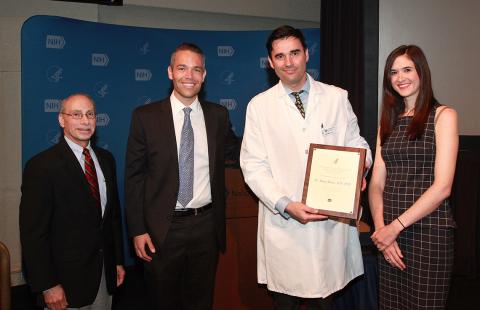‘They Are Beautiful’
Klion Examines Role of Eosinophils in Health, Disease

Photo: Debbie Accame
Birds have them. Bees may have them. So do sea cucumbers and giant cockroaches. Eosinophils—primitive cells that have been described in all vertebrates, and which can probably be found in invertebrates, too—are longtime lodgers within the human frame.
When they stay where they are supposed to—that is, not in the lung, esophagus or skin—they are useful, even beautiful, says Dr. Amy Klion, who gave the season’s final Great Teachers version of Clinical Center Grand Rounds on June 12.
“They must do something, so why do we all have them?” said Klion, senior clinical investigator and head of the human eosinophil section of NIAID’s Laboratory of Parasitic Diseases.
Like the hosts within which they reside, eosinophils can be troublemakers or helpmates. When they break bad, “they really are packets of destruction,” said Klion. They can recruit cytokines, chemokines and other inflammatory cells, leading to fibrogenesis (growth of excess fibrous connective tissue) and hypercoagulability of the blood, among other problems.
“They do something good, too,” added Klion, who described studies primarily in mice over the past 5-10 years showing that eosinophils play a role in glucose metabolism, regulation of gut immunity, tissue remodeling and tumor surveillance, among other talents.
Her laboratory is translational, examining the genetic and immunologic drivers of what is known as hypereosinophilic syndrome (HES) with the goal of treating patients. Unfortunately, “almost nothing is approved for eosinophilic disorders,” Klion said.
HES is diagnosed when eosinophils exceed a count of 1,500/mm3 in at least two samples. It can be caused by parasites, viral infection, even cancer. In patients with eosinophilic esophagitis, food is the likely allergen.
HES results in organ damage, most commonly to the skin, but can also have pulmonary, gastrointestinal, neurologic and rheumatologic effects.
Klion has spent the last 20 years studying clinical subtypes of HES and has seen more than 500 patients with the disease at the CC during that time. Because the treatment for each subtype is different, it is important to know whether the syndrome arises from a myeloid disorder, or is lymphocyte-driven, or if it is familial, parasitic or idiopathic in nature.
“You wouldn’t use steroids if a parasite [such as the Loa loa worm] was causing the disease,” she said.
Conventional therapy for HES has been unsatisfactory, Klion reported, and includes prednisone, hydroxyurea, interferon and the enzyme inhibitor imatinib, which can be curative, but only in a small subset of patients.
“These are chronic diseases, and most people quit therapy eventually due to toxicity,” she said.

Photo: Debbie Accame
It was easy to appreciate how Klion earned Great Teacher status as she clearly explained decades worth of detective work, parsing out biomarkers that identify HES subtypes, and which targeted therapies (among them imatinib, reslizumab, mepolizumab and benralizumab) seem effective as treatment.
Several of the antibodies target interleukin-5, a cytokine that Klion has found to be important at every stage of an eosinophil’s career.
There still need to be more drugs, she insisted, showing slides of a female patient who dramatically improved after treatment with benralizumab. “There is absolutely room for more new kids on the block.”
Interestingly, drugs that remove eosinophils don’t seem to harm patients, Klion said. Though acknowledging that eosinophils have a good side to them, Klion says it appears that they can be happily lived without.
She concluded by underscoring the need for clinicians to know which clinical subtype of HES they are dealing with, because it drives the selection of therapy.
During a brief Q&A, Klion explained that eosinophils are thought to be part of a person’s innate immune system, but likely in some sort of redundant role. As a member of the Laboratory of Parasitic Diseases since 1997 (and a fellow in LPD from 1989 to 1991), she has learned at least one thing:
“If you make the eosinophils go away, the patient gets better.”

